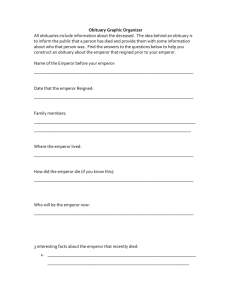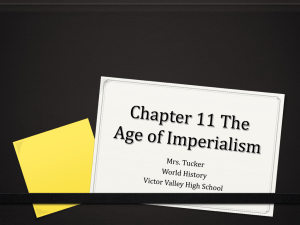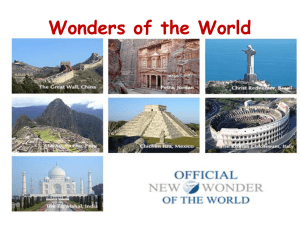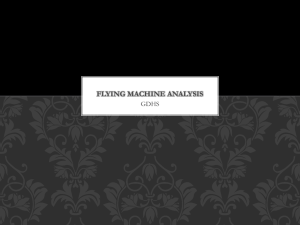The Flying Machine
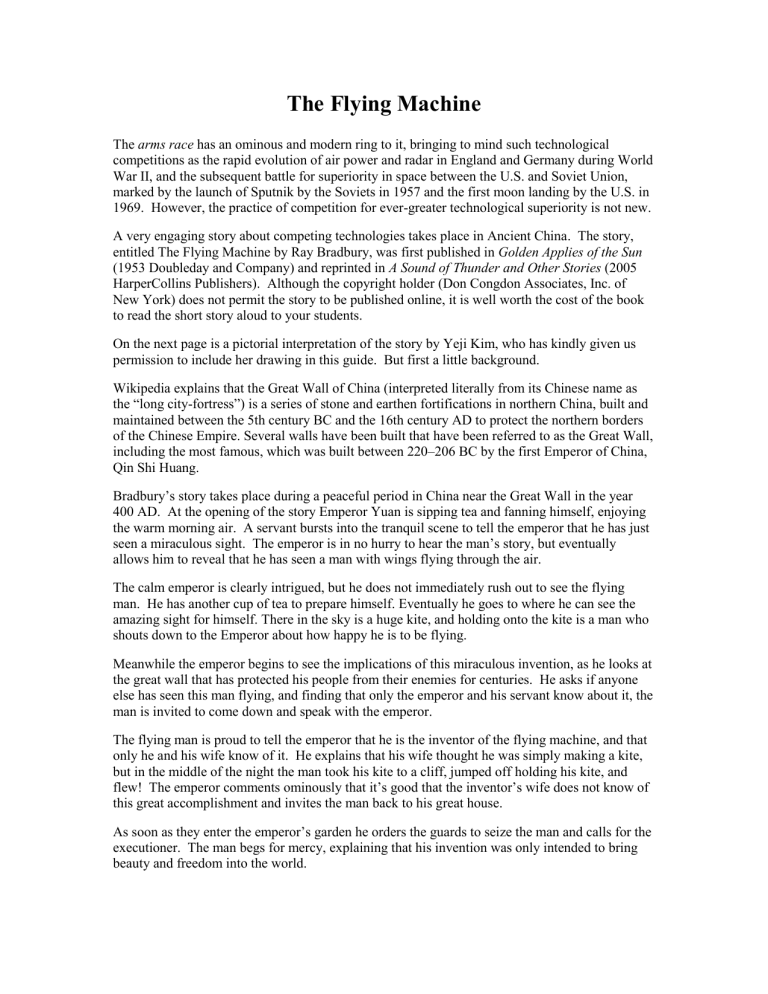
The Flying Machine
The arms race has an ominous and modern ring to it, bringing to mind such technological competitions as the rapid evolution of air power and radar in England and Germany during World
War II, and the subsequent battle for superiority in space between the U.S. and Soviet Union, marked by the launch of Sputnik by the Soviets in 1957 and the first moon landing by the U.S. in
1969. However, the practice of competition for ever-greater technological superiority is not new.
A very engaging story about competing technologies takes place in Ancient China. The story, entitled The Flying Machine by Ray Bradbury, was first published in Golden Applies of the Sun
(1953 Doubleday and Company) and reprinted in A Sound of Thunder and Other Stories (2005
HarperCollins Publishers). Although the copyright holder (Don Congdon Associates, Inc. of
New York) does not permit the story to be published online, it is well worth the cost of the book to read the short story aloud to your students.
On the next page is a pictorial interpretation of the story by Yeji Kim, who has kindly given us permission to include her drawing in this guide. But first a little background.
Wikipedia explains that the Great Wall of China (interpreted literally from its Chinese name as the “long city-fortress”) is a series of stone and earthen fortifications in northern China, built and maintained between the 5th century BC and the 16th century AD to protect the northern borders of the Chinese Empire. Several walls have been built that have been referred to as the Great Wall, including the most famous, which was built between 220–206 BC by the first Emperor of China,
Qin Shi Huang.
Bradbury’s story takes place during a peaceful period in China near the Great Wall in the year
400 AD. At the opening of the story Emperor Yuan is sipping tea and fanning himself, enjoying the warm morning air. A servant bursts into the tranquil scene to tell the emperor that he has just seen a miraculous sight. The emperor is in no hurry to hear the man’s story, but eventually allows him to reveal that he has seen a man with wings flying through the air.
The calm emperor is clearly intrigued, but he does not immediately rush out to see the flying man. He has another cup of tea to prepare himself. Eventually he goes to where he can see the amazing sight for himself. There in the sky is a huge kite, and holding onto the kite is a man who shouts down to the Emperor about how happy he is to be flying.
Meanwhile the emperor begins to see the implications of this miraculous invention, as he looks at the great wall that has protected his people from their enemies for centuries. He asks if anyone else has seen this man flying, and finding that only the emperor and his servant know about it, the man is invited to come down and speak with the emperor.
The flying man is proud to tell the emperor that he is the inventor of the flying machine, and that only he and his wife know of it. He explains that his wife thought he was simply making a kite, but in the middle of the night the man took his kite to a cliff, jumped off holding his kite, and flew! The emperor comments ominously that it’s good that the inventor’s wife does not know of this great accomplishment and invites the man back to his great house.
As soon as they enter the emperor’s garden he orders the guards to seize the man and calls for the executioner. The man begs for mercy, explaining that his invention was only intended to bring beauty and freedom into the world.
"Yes," said the Emperor sadly, "I know it must be true. For I felt my heart move with you in the air and I wondered: What is it like? How does it feel? How do the distant pools look from so high? And how my houses and servants? Like ants? And how the distant towns not yet awake?... But there are times," said the Emperor, more sadly still, "when one must lose a little beauty if one is to keep what little beauty one already has. I do not fear you, yourself, but I fear another man… [with] an evil face and an evil heart, and the beauty will be gone. It is this man I fear.
No one moved or said a word. “Off with his head,” said the Emperor.
Ms. Kim’s illustration of the scene is shown below. She describes the scene that she has painted as follows: “The appearance of the Emperor is impressive. His robes are light colored and he wears a traditional ornament on his head. Every piece of cloth he is wearing is decorated with gold and silver, including the sheath of the sword he is carrying, which is the symbol of his power. The emperor stands firm and upright and seems to be a glorious example of a powerful king who has nothing to worry about. But he is a much more serious character.
“On his left waist there is a cloth tugged in his belt with the Chinese word for peace written on it in silver.
The cloth itself is green—the color of peace and hope. But at the same time the color seems to be far too dark to symbolize such optimism. Another cloth, covering the back of the
Emperor, is blue which stands for tranquility. Those are exactly the things the Emperor strives to maintain, no matter the cost. He does not even hesitate to kill an innocent man in order to do that, which is the reason why the sheath of his sword is dark red—the color of dried blood—and the belt, which holds the cloths, symbolizing peace, hope and tranquility. The belt, which stands for the measures he takes to protect his ideals, is black with a slim gold line in the middle, indicating his good intentions. His main robe is yellow – the color of envy which cannot be hidden by the pieces of cloth on his belt. Although the Emperor’s intentions are noble and it is never explicitly said in the story, the reader gets the impression that he—as the man with the most powerful position in China and therefore bound to his responsibilities—envies the flier of the kite who seems to be so very free.”
Drawing to illustrate "The Flying Machine" is included in this guide by courtesy of the artist, Yeji Kim. For permission to use the image for other purposes please contact Yeji Kim <yeji.kim@charite.de>.
Discussion
“The Flying Machine” concerns two technological innovations: The Great Wall of China and the flying machine itself. Based on the following Washington State Science Standards, how would you structure a discussion or class activity based on the story among high school students? How would know they have a growing understanding of the standard through use of this story? What student work would provide you evidence for the student’s increased understanding?
9-11
PS1E
9-12
SYSC
9-12
INQE
Model
9-12
APPE
9-12
APPF
Content Standards Performance Expectations
Students know that:
Big Idea: Force and Motion: Newton’s
Laws:
Whenever one object exerts a force on another object, a force of equal magnitude is exerted on the first object in the opposite direction. (Newton’s Third Law of Motion )
Students are expected to:
Illustrate with everyday examples that for every action there is an equal and opposite reaction
(e.g., a person exerts the same force on the
Earth as the Earth exerts on the person).
Big Idea: Predictability and Feedback:
In complex systems , entirely new and unpredictable properties may emerge.
Consequently, modeling a complex system in sufficient detail to make reliable predictions may not be possible.
Create a simplified model of a complex system .
Trace the possible consequences of a change in one part of the system and explain how the simplified model may not be adequate to reliably predict consequences.
Big Idea: Conduction Analyses and
Thinking Logically:
The essence of scientific investigation involves the development of a theory or conceptual model that can generate testable predictions.
Big Idea: Science, Technology, and
Problem Solving:
Perfect solutions do not exist. All technological solutions involve trade-offs in which decisions to include more of one quality means less of another. All solutions involve consequences, some intended, others not.
Big Idea: Science, Technology, and
Problem Solving:
It is important for all citizens to apply science and technology to critical issues that influence society.
Formulate one or more hypotheses based on a model or theory of a causal relationship .
Demonstrate creativity and critical thinking to formulate and evaluate the hypotheses .
Analyze a societal issue that may be addressed through science and/or technology . Compare alternative solutions by considering trade-offs and unintended consequences (e.g., removing dams to increase salmon spawning).
Critically analyze scientific information in current events to make personal choices or to understand public-policy decisions.

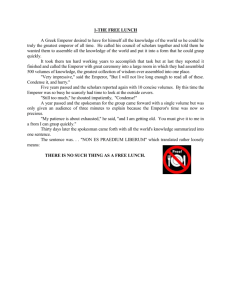
![Procopios: on the Great Church, [Hagia Sophia]](http://s3.studylib.net/store/data/007652379_2-ff334a974e7276b16ede35ddfd8a680d-300x300.png)

